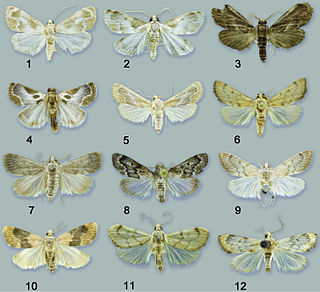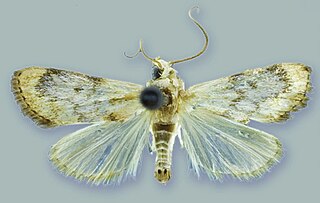
Cataclysta lemnata, the small china-mark, is a moth species of the family Crambidae. It is found in Europe, Morocco and Iran.

Nomophila noctuella, the rush veneer, is a species of moth of the family Crambidae.

Parapoynx stratiotata, the ringed china-mark, is a moth of the family Crambidae. The species was first described by Carl Linnaeus in his 1758 10th edition of Systema Naturae. It is found in Europe where the distribution area extends in the north to the British Isles including Ireland and in the south to Sardinia, Sicily and Greece. The species is also found across the Palearctic in North Africa, Lebanon, Turkey, Azerbaijan, Kyrgyzstan, Uzbekistan and China..
Paracataclysta is a monotypic moth genus in the family Crambidae described by Yutaka Yoshiyasu in 1983. Its single species, Paracataclysta fuscalis, was described by George Hampson in 1893. It is found in South-east Asia, northern Australia and Africa.

Schacontia is a genus of moths of the family Crambidae described by Harrison Gray Dyar Jr. in 1914.

Euchromius ocellea, the necklace veneer or belted grass-veneer, is a cosmopolitan migratory species of moth of the family Crambidae, first described by Adrian Hardy Haworth in 1811. It has Hodges number 5454.

Schacontia chanesalis is a moth of the family Crambidae described by Herbert Druce in 1899. It is found in Mexico, Guatemala, Costa Rica and Venezuela.

Schacontia umbra is a moth of the family Crambidae described by Maria Alma Solis and Paul Z. Goldstein in 2013. It is found in central Ecuador.

Schacontia speciosa is a moth of the family Crambidae described by Maria Alma Solis and Paul Z. Goldstein in 2013. It is found in south-eastern Brazil.

Schacontia themis is a moth of the family Crambidae described by Maria Alma Solis and Paul Z. Goldstein in 2013. It is found on the Cayman Islands and in Brazil, Costa Rica, Cuba, the Dominican Republic, Florida, Jamaica, Mexico, Panama, Puerto Rico and Venezuela.

Schacontia rasa is a moth of the family Crambidae described by Maria Alma Solis and Paul Z. Goldstein in 2013. It is found in Mexico, Cuba and the Dominican Republic.

Schacontia nyx is a moth of the family Crambidae described by Maria Alma Solis and Paul Z. Goldstein in 2013. It is found in northern Venezuela.

Schacontia clotho is a moth of the family Crambidae described by Maria Alma Solis and Paul Z. Goldstein in 2013. It is found in southern Ecuador.

Schacontia lachesis is a moth of the family Crambidae described by Maria Alma Solis and Paul Z. Goldstein in 2013. It is found in central Brazil and Bolivia.

Schacontia atropos is a moth of the family Crambidae described by Maria Alma Solis and Paul Z. Goldstein. It is found in northern Venezuela.

Schacontia ysticalis is a moth of the family Crambidae described by Harrison Gray Dyar Jr. in 1925. It is found in Mexico, Costa Rica, Honduras, Nicaragua, Venezuela and Bolivia.

Cybalomiinae is a subfamily of the lepidopteran family Crambidae. It was described by Hubert Marion in 1955.

Glaphyriinae is a subfamily of the lepidopteran family Crambidae. It was described by William Trowbridge Merrifield Forbes in 1923. The subfamily currently comprises 509 species in 75 genera.

Scopariinae is a subfamily of the lepidopteran family Crambidae. The subfamily was described by Achille Guenée in 1854.

















